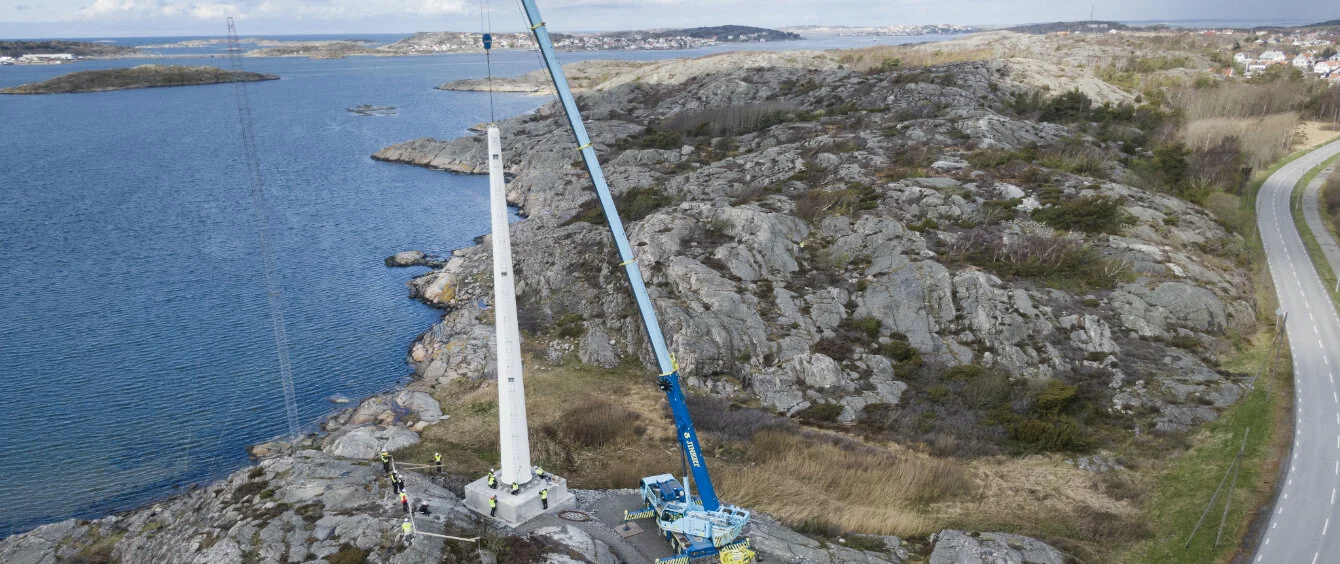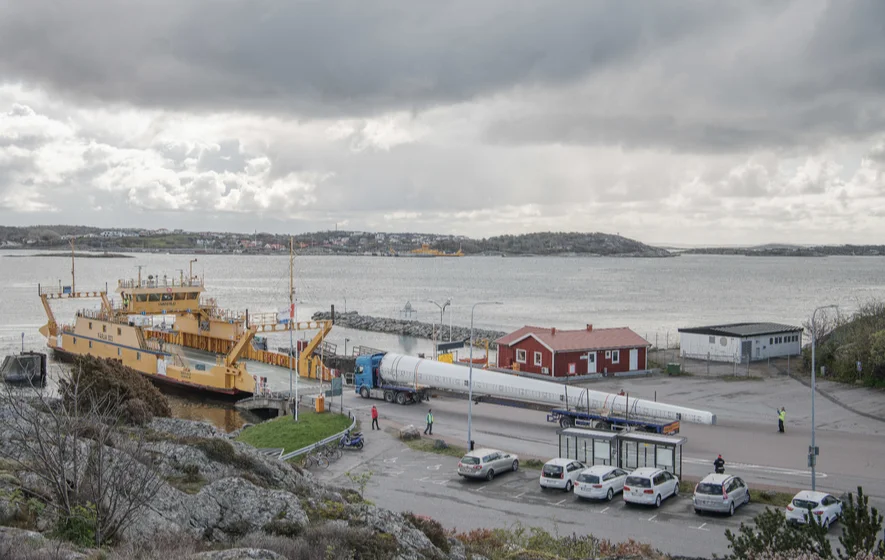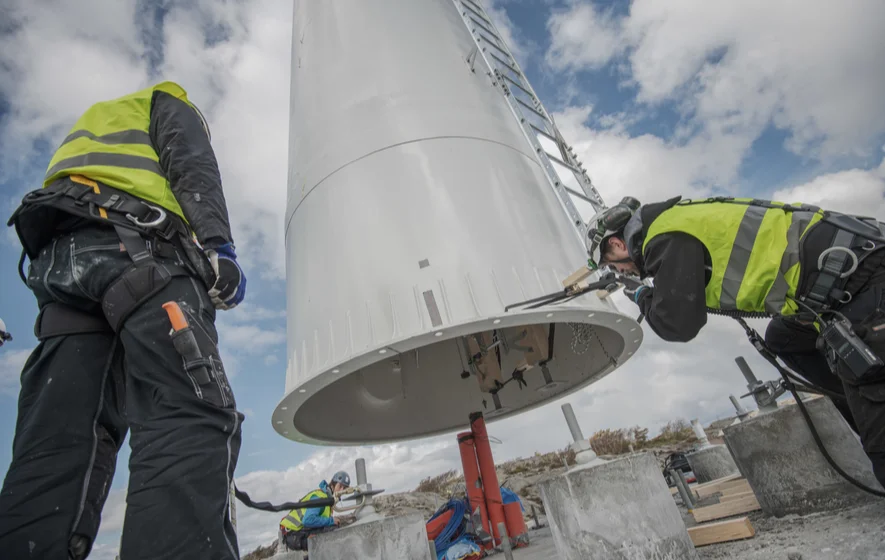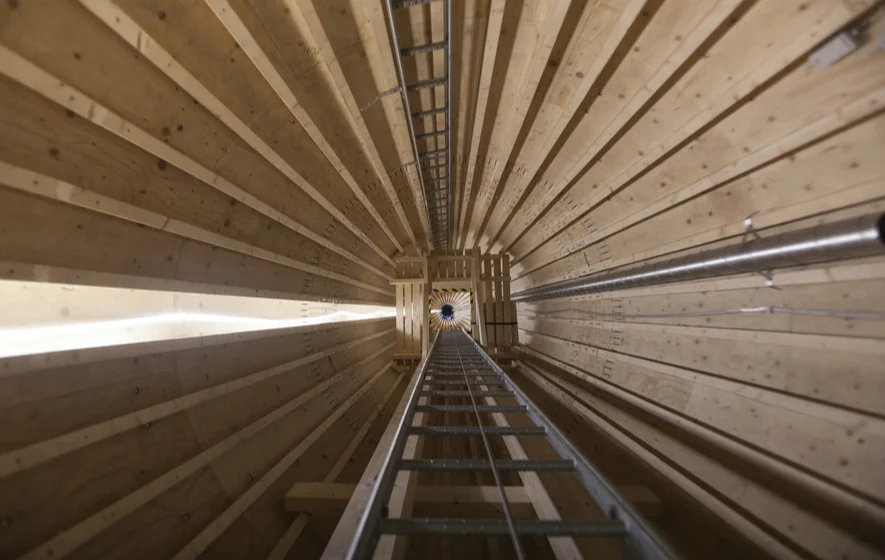At first glance, the 30-metre tower of the wind turbine on the Swedish Isle of Björkö near Gothenburg looks like any other. Emerging from the foundation in the rocky coastline is a white tower that tapers as it rises into the sky, with three rotor blades attached to its tip. However, its internals are anything but common. This is where it becomes obvious that the tower is not made of steel, but of many small, elongate wood elements. These beams are bound to form a long tube, with two ladders with innumerable steps leading to the top and a platform – also made of wood – located half way up.
The prototype, which has been on Björkö since April, is the first of its kind. It is much smaller than commercial units and does not generate any electricity yet since it lacks a generator at the top of the tower. Swedish engineering and industrial design firm Modvion AB is using the structure to perform tests on commission from the Swedish Wind Power Centre (SWPTC) at Chalmers Technical University in Gothenburg to determine whether increased use can be made of timber in the construction of wind turbines.
Steel production is CO2-intensive
The idea is to improve the environmental footprint of wind turbines using wood as a renewable resource. After all, wind turbines may generate green electricity, but the production of the steel used to manufacture them emits large amounts of carbon dioxide. According to the German Metalworkers Union, depending on the production technique, up to 1.8 metric tons of carbon dioxide are emitted for every metric ton of steel produced. The by far largest share of the steel is used for the tower, the biggest and heaviest part of every wind turbine.
Nevertheless, wind energy will play a major role en route to establishing a more sustainable energy supply system, as confirmed by SWPTC Director Ola Carlson: “Calculations have wind power becoming the EU’s largest source of energy by as early as 2027.” Wooden wind turbine towers could thus spur the energy transition as they would eliminate related greenhouse gas emissions from steel production and the CO2 bound in the wood would be stored in the structure for many years.
Wooden towers are lighter but sturdy
According to the German Wind Energy Association, wind turbines with steel tube towers are the most common variant, while reinforced concrete is less widespread. A 120 metre tower can weigh up to 250 metric tons. It is made up of several large components of 20 to 30 metres in length, which are difficult to transport. The higher the wind turbine, the thicker the tower walls have to be to ensure structural stability. This is reflected in both weight and cost. Transportation and assembly of the tower account for up to 25 percent of the total cost of a wind turbine.
Modvion Managing Director Otto Lundman explains that, when used as a building material, timber offers several advantages in addition to its positive climate footprint: “Pound for pound, composite wood is 55 percent stronger than steel, and thanks to the modular structure, the wind turbines can be mounted higher.”
Components made of Nordic spruce wood
The timber for the tower on Björkö is much lighter than steel, is easier to transport and is cheaper to boot. The components are made of Nordic spruce. Several three-to-four-millimetre thick layers of this wood were glued and given a waterproof coating in the Moelven laminated timber factory in Töreboda. Modvion claims that this will make the timber wind and weather-resistant for decades, after which the wooden components can be fully recycled.
“Wood has fantastic properties and we must build much more from wood if we want to achieve the climate goals,” says Johan Ehlén, Managing Director of the factory in Töreboda. He and his team spent the last few years working on the tower’s design.
Wind turbine to receive generator soon
The wooden tower is currently being used for research. However, the machine room and rotor blades have already been installed. Plans envisage a small, 40 kilowatt, generator being fitted to the top of the tower this year, enabling the wind turbine to produce power. By comparison, modern onshore wind turbines can output over 4 megawatts.
According to Modvion, however, system size does not pose a problem. Towers with heights of up to 159 metres are to be built using this technology after the test phase. This would give them the same hub height as modern low-speed onshore wind turbines and enable them to bear large, more powerful turbines as well.
Construction of the wooden wind turbine tower on Björkö
Interest in wooden towers already kindled
Construction of the first commercial wind turbine featuring a wooden tower is scheduled to begin as early as 2022. Rabbalshede Kraft has already signed a letter of intent with Modvion to this effect. The operator of wind turbines in the Nordic region plans to build ten towers with heights of at least 150 metres in the Fägremo wind farm in the vicinity of Töreboda on successful conclusion of the trial run on Björkö.
“Modvion’s timber modules keep us from running into logistical problems while reducing weight and making a major step towards completely carbon-neutral wind power,” declares Peter Wesslau, CEO of Rabbalshede Kraft. “A welcome side-effect is that construction can take place so close to the wind farm in Töreboda.”
Based on Otto Lundman’s calculations, every large wooden tower would save about 2,000 metric tons of CO2 compared to steel during production. He is convinced that this could revolutionise wind energy: “This major breakthrough will pave the way for the next generation of wind turbines.”
Sweden had a total of 8,985 MW in installed wind capacity in 2019. This ranks the country sixth in Europe. In sum, wind power accounted to 15 percent, or 205 gigawatts, of the European energy mix.
Sweden installed 1,588 MW in wind capacity in 2019. Fourth spot in Europe.
A total of 179 wind turbines are being built in Markbygden Ett, Europe’s biggest onshore wind farm in northern Sweden.
Photo and video credit: © Modvion AB



